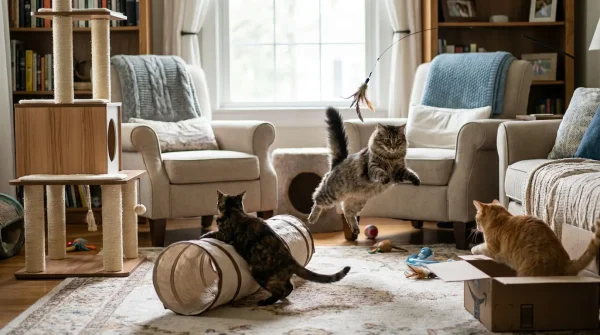Common Cat Behavior Problems Solved: Expert Guide for Irish Cat Owners
Understanding Cat Behavior Problems: A Complete Guide
Cats are wonderful companions, but sometimes their natural instincts and behaviors can create challenges for pet owners. From inappropriate urination to aggressive scratching, cat behavior problems can strain the bond between you and your feline friend. This comprehensive guide explores the most common cat behavior issues faced by Irish cat owners and provides proven, veterinary-approved solutions to restore harmony in your home.
Key Takeaway: Most cat behavior problems stem from unmet needs, stress, or medical issues—not from spite. Understanding the root cause is the first step to solving any feline behavior challenge.
Most Common Cat Behavior Problems
1. Inappropriate Urination and Spraying
The Problem: Your cat is urinating outside the litter box or spraying on vertical surfaces like walls and furniture.
Why It Happens:
- Medical issues: Urinary tract infections, kidney disease, or diabetes
- Litter box problems: Dirty box, wrong litter type, or inadequate number of boxes
- Stress and anxiety: Changes in environment, new pets, or household tension
- Territorial marking: Unneutered males marking territory
Solutions That Work:
- Vet check first: Rule out medical causes immediately—this is crucial!
- Optimize the litter box: Use unscented clumping litter, scoop daily, and provide one box per cat plus one extra
- Location matters: Place boxes in quiet, accessible areas away from food and water
- Clean thoroughly: Use enzymatic cleaners (not ammonia-based) to eliminate odors
- Reduce stress: Provide vertical spaces, hiding spots, and maintain consistent routines
2. Destructive Scratching
The Problem: Your cat is scratching furniture, carpets, or door frames.
Why It Happens: Scratching is a natural, necessary behavior for cats to mark territory, stretch muscles, and maintain claw health. They’re not being “bad”—they’re being cats!
Solutions That Work:
- Provide alternatives: Offer multiple scratching posts (sisal, carpet, and cardboard) in strategic locations
- Position strategically: Place posts near sleeping areas and entry points where cats naturally scratch
- Make furniture unappealing: Use double-sided tape, aluminum foil, or commercially available deterrents temporarily
- Reward good behavior: Praise and treat your cat when they use appropriate scratching surfaces
- Trim claws regularly: Monthly nail trims reduce damage (learn proper technique or ask your vet)
Pro Tip: Cats prefer tall, sturdy scratching posts they can fully stretch on—at least 30 inches high for most adult cats.
3. Aggression Toward People or Other Pets
The Problem: Your cat hisses, swats, bites, or shows other aggressive behaviors.
Why It Happens:
- Fear-based aggression: Previous trauma, lack of socialization, or feeling cornered
- Play aggression: Kittens and young cats using teeth and claws inappropriately during play
- Petting-induced aggression: Overstimulation from too much petting
- Redirected aggression: Cat is aroused by something they can’t access (outdoor cat, bird) and lashes out at nearest target
- Pain-induced: Underlying medical conditions causing irritability
Solutions That Work:
- Never punish: Punishment increases fear and worsens aggression
- Identify triggers: Keep a behavior diary to spot patterns
- Provide safe spaces: Ensure your cat has escape routes and high perches
- Enrich the environment: Increase play sessions (2-3 daily) with interactive toys
- Slow introductions: For inter-cat aggression, use gradual scent swapping and visual introductions
- Consult professionals: Severe cases may need a veterinary behaviorist
4. Excessive Meowing or Vocalization
The Problem: Your cat meows constantly, especially at night.
Why It Happens:
- Attention-seeking: Learned that meowing gets a response from you
- Cognitive dysfunction: Senior cats may vocalize from confusion (similar to dementia)
- Hunger: Inconsistent feeding schedules
- Breeding behavior: Unspayed females in heat or unneutered males seeking mates
- Medical issues: Hyperthyroidism, high blood pressure, or pain
Solutions That Work:
- Vet examination: Essential for ruling out medical causes, especially in older cats
- Don’t reward the behavior: Ignore attention-seeking meowing (hard but effective)
- Establish routines: Feed at consistent times and provide pre-bedtime play sessions
- Enrich the environment: Puzzle feeders and toys keep cats occupied
- For senior cats: Night lights and comfort items can reduce anxiety
Medical Causes of Behavior Problems: When to See Your Vet
Many behavior issues have underlying medical causes. Always rule out health problems first before assuming it’s purely behavioral. Schedule a veterinary appointment if your cat shows:
- Sudden behavior changes
- Elimination problems
- Increased aggression
- Excessive grooming or self-mutilation
- Changes in appetite or thirst
- Lethargy or withdrawal
- Senior cats showing new behaviors
Common medical issues that manifest as behavior problems include:
- Urinary tract disease: Pain causing litter box avoidance
- Arthritis: Pain making it hard to access litter boxes or causing irritability
- Dental disease: Oral pain leading to aggression or reduced grooming
- Hyperthyroidism: Causing increased vocalization and restlessness
- Cognitive dysfunction: Senior cat confusion and anxiety
Environmental Enrichment: Preventing Behavior Problems
The best approach to cat behavior problems is prevention through proper environmental enrichment. A happy, stimulated cat is less likely to develop problem behaviors.
Essential Enrichment for Irish Cats:
1. Vertical Territory
Provide cat trees, wall-mounted shelves, or window perches. Cats feel secure with elevated vantage points, especially in multi-pet households.
2. Interactive Play
Schedule 2-3 short play sessions daily (10-15 minutes) with wand toys that mimic prey movement. This satisfies hunting instincts and reduces problem behaviors.
3. Puzzle Feeders
Make mealtime mentally stimulating with food puzzles. This is especially important for indoor cats who don’t hunt.
4. Safe Outdoor Access
Consider a catio (cat patio) or leash training for supervised outdoor time. Irish weather-resistant options are available.
5. Multiple Resources
In multi-cat homes, provide multiple food stations, water bowls, litter boxes, and scratching posts to reduce competition.
6. Scratching Options
Offer various scratching surfaces (sisal, cardboard, carpet) in different locations throughout your home.
When to Seek Professional Help
While many behavior problems can be resolved with the strategies above, some situations require professional intervention:
- Severe aggression: Bites that break skin or attacks without warning
- Persistent elimination problems: After medical issues are ruled out and environmental changes made
- Self-harm: Excessive grooming to the point of hair loss or skin damage
- Senior cat behavioral changes: Especially if accompanied by other symptoms
Consult with:
- Your veterinarian: Rule out medical causes first
- Veterinary behaviorist: Specialists with advanced training in animal behavior
- Certified cat behavior consultant: Professional trainers specializing in feline behavior
Creating a Cat-Friendly Home in Ireland
Irish cat owners face unique considerations given our climate and housing. Here are specific tips for creating an ideal environment:
Weather-Related Considerations:
- Damp conditions: Ensure litter boxes stay dry and are placed away from drafts
- Colder months: Provide warm bedding and consider heated beds for senior cats
- Indoor enrichment: With more indoor time during rainy periods, increase interactive play and mental stimulation
Housing Considerations:
- Smaller homes/flats: Maximize vertical space with tall cat trees and wall-mounted perches
- Shared walls: Consider silent interactive toys to avoid disturbing neighbors
- Window entertainment: Window perches provide visual stimulation, especially important for indoor-only cats
Success Stories: Real Results from Irish Cat Owners
“Our 3-year-old tabby, Luna, started urinating on the sofa after we moved to Dublin. We thought she was angry with us, but our vet discovered a urinary tract infection. After treatment and adding a second litter box, she’s back to her perfect litter box habits.”
— Sarah, Dublin cat owner
“Milo was attacking our ankles every evening. We started two 15-minute play sessions with a feather wand before dinner, and the difference is incredible. He’s exhausted his hunting instinct and is much calmer.”
— James, Cork cat owner
Final Thoughts: Patience and Understanding
Resolving cat behavior problems requires patience, consistency, and understanding. Remember:
- Your cat isn’t misbehaving to upset you—they’re communicating a need
- Most problems have solutions when you identify the underlying cause
- Prevention through enrichment is easier than fixing established problems
- Never hesitate to seek veterinary advice—health issues are common culprits
With the strategies outlined in this guide, you can address most common cat behavior problems and strengthen the bond with your feline companion. A happy cat makes for a happy home!
Shop PetPal.ie for Cat Behavior Solutions
Find everything you need to address cat behavior problems:
- Premium scratching posts and cat trees
- Interactive toys and puzzle feeders
- Calming pheromone diffusers
- Enzymatic cleaners for accidents
- Premium litter and litter boxes
Visit PetPal.ie for Ireland’s best cat care products!





